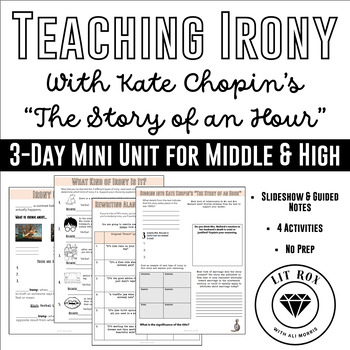Literary Elements: Irony w/ Kate Chopin's "The Story of an Hour" Mini Unit
- Zip
Also included in
- Whether you’re starting off the year teaching plot, conflict, irony, theme, mood, author's tone, and symbolism or doing refreshers throughout the year, these mini units are perfect for engaging your students and firmly teaching and assessing the various concepts.Pairing each literary element with aPrice $18.00Original Price $34.00Save $16.00
Description
Teaching irony and other literary elements at the beginning of the year or doing an end of the year refresher? This mini unit is perfect for engaging your students and firmly teaching and assessing the concept of irony.
Kate Chopin's "The Story of an Hour" is a perfect short story to explore the different types of irony. I use this in my own high school classroom. This resource includes:
•Irony Slideshow
•2-Page Guided Fill-In Notes
•3 pages of irony exercises including rewriting Alanis Morissette "Ironic" lyrics
•Short Story "The Story of an Hour"
•Engaging Reading Comprehension Questions
Please enjoy and let me know how it went!
Check out my proofreading resources:
Full Year of Proofreading Bell Ringers w/ Editing Marks & Slideshow! No Prep!
20 September-Themed Proofreading Paragraph Bell Ringers with Editing Marks
20 October-Themed Proofreading Paragraph Bell Ringer Worksheets w/ Editing Marks
20 November Proofreading Paragraphs Bell Ringers with Editing Marks
20 December Proofreading Paragraphs and Slideshow Bell Ringers w/ Editing Marks
20 January Proofreading Paragraphs and Slideshow Bell Ringers with Editing Marks
20 February Proofreading Paragraphs and Slideshow Bell Ringers w/ Editing Marks
20 March Proofreading Paragraphs and Slideshow Bell Ringers w/ Editing Marks
20 April Proofreading Paragraphs and Slideshow Bell Ringers w/ Editing Marks
20 May-Themed Proofreading Bell Ringer Worksheets & Slideshow with Editing Marks
20 June-Themed Proofreading Bell Ringer Worksheets &Slideshow with Editing Marks
Check out my Short Story Mini-Unit Student Workbook Resources:
Short Story Mini-Unit Student Workbook for Ray Bradbury's "All Summer in a Day"
Short Story Mini-Unit Student Workbook for Ray Bradbury's "Marionettes, Inc."
Short Story Mini-Unit Student Workbook for Edgar Allan Poe's "Cask of Amontillado"
Short Story Mini-Unit Student Workbook for Ursula K. Le Guin's "The Wife's Story"
Short Story Mini-Unit Student Workbook for Kurt Vonnegut's "Harrison Bergeron"
Short Story Mini-Unit Student Workbook for Walter Dean Myers' "Big Joe's Funeral"
Check out my Broadway Close Reading resources:
Close Reading Broadway: Rent's "One Song Glory"
Close Reading Broadway: Wicked's "For Good"
Close Reading Broadway: Spring Awakening's "I Don't Do Sadness/Blue Wind"
Check out my Disney Close Reading resources:
Close Reading Disney: The Little Mermaid's "Part of Your World"
Close Reading Disney: The Lion King's "Hakuna Matata"
Close Reading Disney: Beauty and the Beast's "Belle"
Close Reading Disney: Hercules' "Go the Distance"
Close Reading Disney: Hunchback's "Out There"
Close Reading Disney: Mulan's "Make a Man Out of You"
Check out my 100-Word Creative Writing Challenges:
100 Word Story Writing Challenge: Trapped No Prep Student Workbook
100 Word Story Writing Challenge: Freedom No Prep Student Workbook
100 Word Story Writing Challenge: Suspicious No Prep Student Workbook






